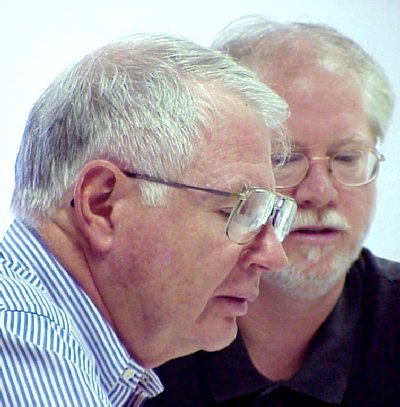
McKay
- The Legend
The Tuesday morning project meeting at the Carillon site was a routine affair. More than midway through construction, the project was now in maximum effort. Twenty subcontractors were around the table, all there protecting their turf. It was positively congenial compared to the meetings we can expect when time and tempers get short toward the end of the job. Besides the usual exchange about shop drawings and delivery dates, the big gripe was raised by the tile setter. The plumber had hung pipe low in the bathrooms, the ceiling installer put the ceiling under it. The tiler was unhappy about having to cut the top row of tile to fit, another victim of the domino effect.
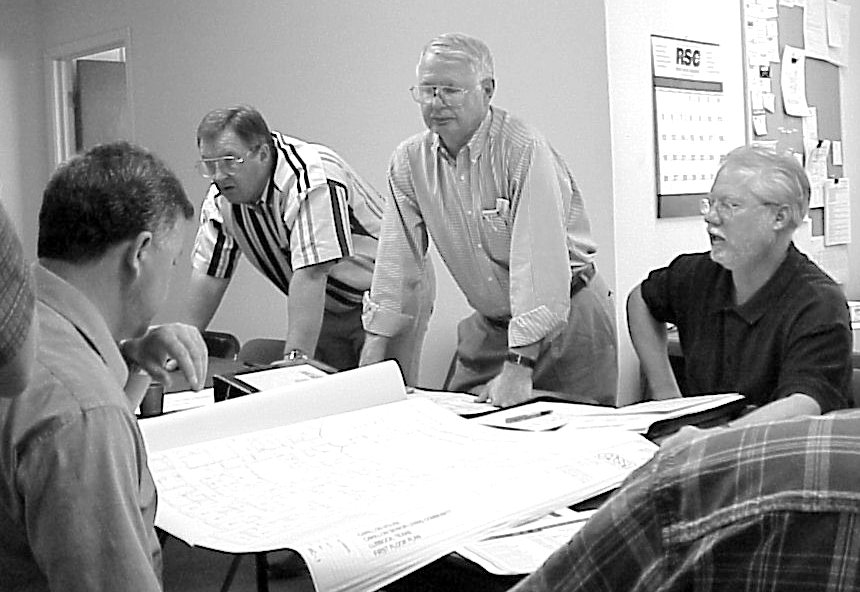
After the meeting Joe McKay, Steve Robinson and I inspected the work of the tinner in the mechanical room. We made a few field adjustments to the plans and answered some questions about the layout. By then it was noon and we went to lunch at Bigham's Smokehouse nearby. Today was rib day, but Joe had the turkey breast with two sides of cole slaw.
Over lunch we talked about how well the job was going. With two massive projects being built on the site simultaneously, the logistics are daunting. Shawn Smith and John Chappel, superintendents for Lee Lewis Construction have both jobs manned and under control. This project will take Lubbock to the next level in retirement living. Blazing a trail to the next level is the unique forte of architect Joe D. McKay.
I took my little tape recorder from my coat pocket and set it on the table. I said, "Joe, I want to interview you for an article in Lubbock Magazine". This was not a total surprise to him, he just did not know today was the day. "Have you thought about you would like to say on the record?"
"Some," he said, "lets talk about the role of the architects in society. The architect can work with a group of people made up of different interests in the community to bring a project to fruition. Without some guidance, a project cannot get to that point. Every project has its own story. I have had the good fortune to be involved in some of them."
Let's get a little specific," I suggested, "I only brought a one hour tape. I have often wondered how one of those "partnership deals" between government and the non-profit private sector is put together. There have been a bunch of them right here in Lubbock.
Offhand, those that come to mind are The Science Spectrum, The Cultural Center, The Food Bank, The Texas Tech Pavilion, The South Plains Children's Shelter, and others.
The common denominator in all these projects seems to be you. Let me put it to you this way: What unique perspective does an architect have that is valuable to partnerships such as these? Talk about the Omnimax theatre first, I know the most about that project."
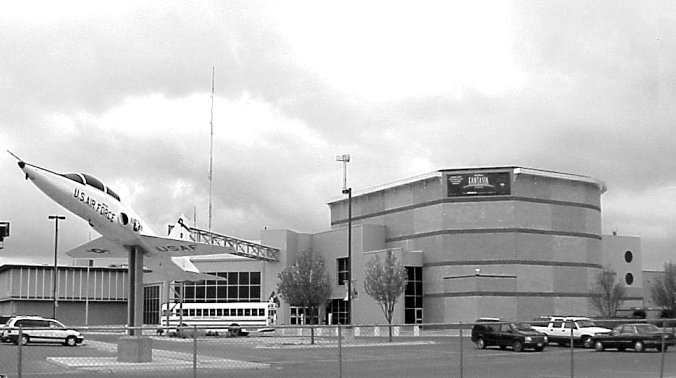
"The Science Spectrum and Omnimax was a partnership effort of our city government and the non-profit organization governed by the Science Spectrum board. The city, in effect, guaranteed the financing of the theatre addition. The purpose was a venue to attract visitors to Lubbock, as well as to educate the young people in our community. It is a co-generational type of venue that allows parents and grandparents to interact with children. That was not previously available in Lubbock."
Steve Robinson, Joe's associate, added, "That led to extended education, summer programs and other good things. We had the old Time DC building to start with. The theatre building shape was dictated by the dome screen and criteria from I-Max Corporation. It was a very interesting project."
McKay continued, "As you know, that was a collaborative effort between Fanning, Fanning & Associates, Inc., Joe D. McKay and Associates, and others. We brought a consulting design architect, Michael Peters, from Texas Tech on board to help with the exterior esthetics and design. We had previously done a thumbnail sketch and we worked the details into that sketch - it was a collaborative effort. We wanted to display the building in a spectacular way. The visual impact of displays that can be seen from the street, day and night, inside and outside, front and back, contribute to that."
Reflecting on what Joe said, and waxing as eloquent as an engineer can, I mused, "It has to be springtime, I see yellow everywhere. The daffodils in my flower bed have bloomed. There is a procession of yellow school busses bound for the Science Spectrum passing my office window. Every school kid in West Texas must make the annual pilgrimage to Lubbock for a day at the Omni. Just having it here really feels great. It does dazzle your senses, and the kid in me still wants to see every show. There was some controversy about the Omnimax Theatre in the beginning, but in the glow of success I don't know anybody who admits they were against it."
"Tell me about the International Cultural Center."

"The International Cultural Center ended up being a partnership between Texas Tech University and a non-profit board. There was a vision by a couple of people in the community to expose students in high school and below, to the cultures of other countries."
For the record, I asked, "Who were the two people?"
"Jay Harris and Dudley Strain," he replied. "Jay recruited Dudley Strain to sell the concept of international cultural education to the community. They struggled a number of years to bring understanding of the public and advocates to the range of possibilities. It did not happen quickly. They were able to approach the university and they became a partner, forming a public/private partnership that worked well.
Jay Harris and Dudley Strain were founding members of the International Cultural Center of Lubbock Inc. which is a non-profit group. It had a board of local citizens who were interested in bringing the concept to fruition. Many people served from time to time, and it was a board of significant influence. I can't recall all their names, but several professors and doctors from other countries served on that board. They were able to reach across borders to support the effort.
They approached several foundations for support. For example the Osteopathic Physicians Foundation donated the globe in front of the building. That was about ninety thousand dollars. The Rand McNally globe inside was sponsored by Southwestern Bell Telephone Foundation. These two globes dominate the vista, one inside and one outside."
I quizzed him about the architectural design of the building.
"It was, I believe, the first effort of the board of reagents to get back to the campus style of architecture on all of their buildings. It was a specific requirement of that particular project. However, the project had previously been designed to have the Mediterranean or Spanish Renaissance flavor at the original site of the old Carroll Thompson Junior High School. Furr Supermarkets acquired that property from the school district and donated a portion of it for an international culture center. Funds were just never raised to build the building at the time the site was available.
When it was built, it became a focal point for international activities. The building has space for research, exhibits, receptions, meetings - demonstrations of things like costumes, native dance, art, a multi-media library and an auditorium. The library is unique because there are not a lot of books there, but it interconnects through the internet to access many other libraries."
I asked "What did Tech get out of the deal?"
"Another part of the mission and goal was to have a place for the international students at the university. There was a need to make sure all their records were complete and to take care of immigration concerns. They now have the full international cultural students administrative services under Idris Traylor, Jr., the director, in the building."
"Lets move on, say, to the South Plains Food Bank," I prompted.
"The Food Bank was given birth by the involvement of Ray and Lou Diekemper and their desire for a non-governmental entity to provide food for people in need. Ray had very strong feelings that there should be no government funds in the project. He acquired the building that we helped renovate and donated it to the Food Bank Corporation, a non-profit organization.
We are now studying an expansion to the food bank. They have grown and it is a model for other food banks around the country. People come to Lubbock to study our food bank to find out how to serve needs without government subsidy. It has been named National Food Bank of the Year and it has received the Second Harvest award of excellence."
A couple of other prominent Lubbock citizens came to mind and I asked, "How did J. T. Talkington and H. A. Sessions get involved with the Food Bank?
"That was a different project. That was the Breedlove Dehydration Plant. It was a spin-off of the South Plains Food Bank. The dehydration plant received its initial support from the Bill and Louise Kingsberry. They gave land for the project on south MLK boulevard. Sufficient construction funds for a new building were not forthcoming at that time, so it was not built. Later, J. T. Talkington and H. A. Sessions, who owned the old Litton Plant on north MLK were approached by the board of the food bank to see if they were interested in donating that building to house the dehydration plant. They were and they did."
"Then, Carolyn Lanier, the driving force as administrator for the food bank, garnered the forces for much of the actual work. In this case it was the county sheriff, Sonny Kessee, and prisoners from the county jail. They were the labor force that gutted that building so it could house the huge dehydrator. They also helped with the finish-out."
" It is interesting that on the Breedlove Plant the board did go to the government for help, but not for money. They worked with Congressman Larry Combest to actually change the law for farmers who receive crop subsidy for crops like onions. Rather than plow that food under, they can now donate it to the food bank."
.
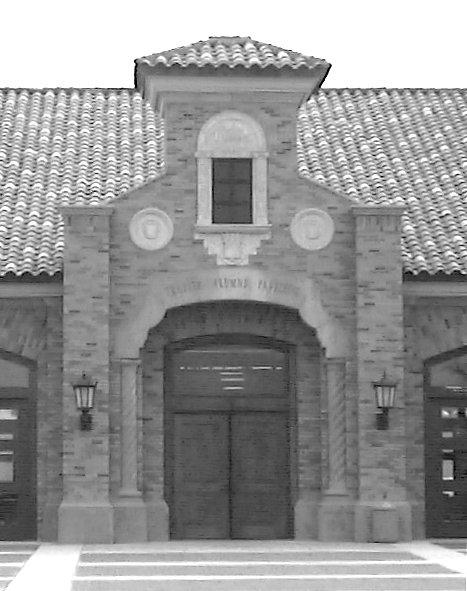
"Ok," I said, "What is the story on Frazier Alumni Pavilion, the building that displaced Raider Alley at football games?"
"That was a non-profit Texas Tech Ex-students Association project. They received from the university a long term lease on some land for the project. Dean Pierce, of Pierce and Winn, Architects, were the design architects and we worked together to develop the plans and details to meet the vision of Jim Sowell for an open air pavilion for game day activities.
They had a fund drive among the ex-students to raise money for construction. There were some large contributions. For example, the Frazier family and Jim Sowell were very generous. Reagent Sowell was the one who first went to the ex-students saying such a place for pre-game and post-game functions was needed. It was his dream to have this facility built. It was also he and John Montford who pushed for Tech to have their own arena on campus after the defeat of the city bond issue. Certainly, this was a significant step for the university to take." In retrospect, it was what they really needed.
Bill Dean, of the Alumni Association, gives glowing reports on the pavilion. Seems like it has taken off as a multi-function facility. It is open every day with a sandwich shop for commuters. Bookings for banquets, weddings, and receptions are solid for the summer, and it is used as a remote dining room for athletes during training.
I mentioned another project that McKay was involved with, not as the architect, but as a concerned citizen: The South Plains Children's Shelter.
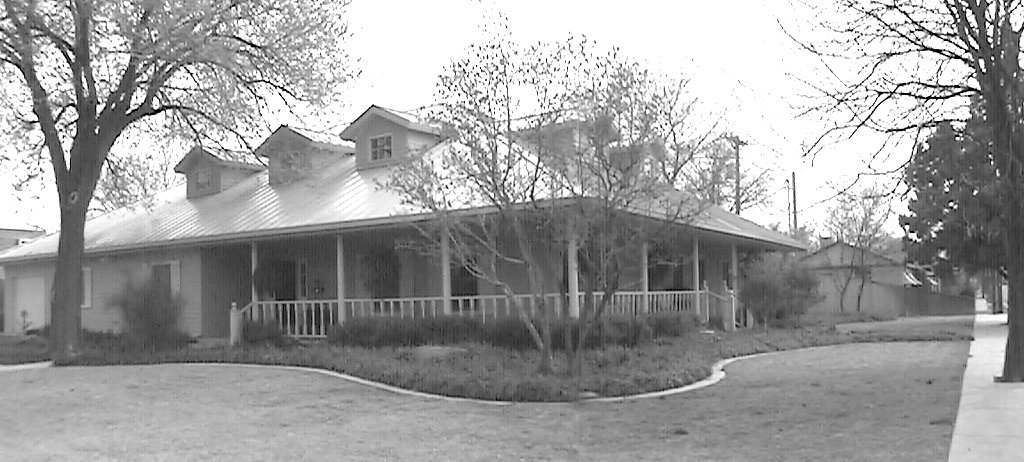
"This undertaking was for the purpose of providing a temporary shelter for displaced children until permanent arrangements could be made for them. There was a study done by the Junior League and the United Way Planning Council that determined the need. A board was formed on which I served as first chairman. The Murfee House was built after a few years. It is a metal roofed building across from the tennis courts on Avenue F. This is a good example of how an architect can serve the community. We can serve on boards and bring some guidance to the planning effort to projects that might not otherwise get started."
Joe was on a roll, and I hated to cut the interview short, but my tape recorder ran dry about then, and we all needed to get back to work. Joe was busy customizing the living units in Windsong for some old friends who are moving in, and I needed to finish some as-built drawings on the utility project for the Indian Health Service at Crownpoint, New Mexico.
That was two weeks ago now, and I set here, well past my bedtime, staring at the screen of my word processor, wondering how to put a frame of words around a legend. Is there some unwritten myth that having Joe McKay involved in the project insures success? When in the development of a concept does somebody say, "We need to get Joe McKay on board." I have worked with him on a hundred and twenty different projects and I know he seems to be the secret ingredient that spells success.
Lubbock's man for all seasons, his contribution to our community has seldom been rivaled: chairman of the Lubbock Chamber of Commerce, president if the Southwest Rotary Club, president of the Lubbock American Institute of Architects, president of Construction Specifications Institute (he single handedly saved the Lubbock Chapter from extinction), recipient of the Tinney Award for Ethics in Business, and on and on.
Sometimes he is the design architect. Sometimes he sits on the board for the owner. Sometimes he is just someone you recognize on a committee. Sometimes he is a hired gun. I can think of a dozen analogies that describes one or more facets of the remarkable Mr. McKay: The glue that holds the deals together. The buffer that cushions the collision of monumental egos. The tether that keeps the cannon from getting loose on the deck. The grease that smoothes the friction inherent in ambitious undertakings. The catalyst that moves dreams off high center. The dash of cold water in the face of unjustified optimism. Reality check for the low bidder.
Joe and Mary Ann McKay are ardent supporters of the Texas Tech athletic program. The bronze plaque on the wall of the Red Raider Club attests to that. You can see McKay's tracks all around the sports facilities. One thing you can say about him: he is a player.
 .
.
In the sports vernacular you could say Joe McKay always plays his assignment to the hilt, no matter what it is. He is sometimes called on to be the blocking back for star architects from Off. He knows the game, he knows the field, and he knows the players. In this role he takes the fake and clears a hole, blocking the line and running interference downfield. This can be a winning strategy, as in the case of United Spirit Arena, or the Athletic Training Center.
Savvy coaches give him the ball. On the biggest projects in Lubbock today; Covenant Health Systems, Municipal Coliseum roof, Windsong and Carillon, he is the quarterback. Now, that makes for a good game plan! Draft talent only when you need it, and depend on proven veterans like McKay to carry the season.
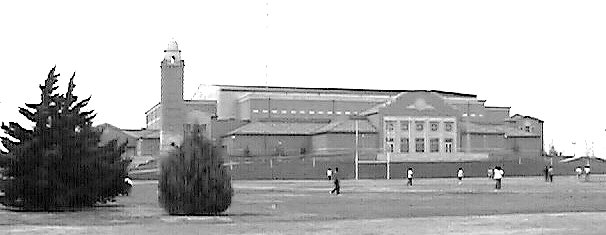
"Legendary Lubbock" became our motto the year Joe McKay was chairman of the Chamber of Commerce. It is altogether fitting that his exploits will be retold as folklore for generations. Let his name be carved in stone. Yes, cornerstones!
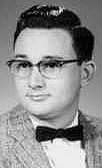
I dedicate these articles to the unsung design community that makes Lubbock, Texas, my hometown, the Florence of the Southwest. Recognition of their contribution to the beauty of our community is long overdue. These interviews will be liberally edited and paraphrased in the interest of brevity and levity. Yes, this is my college picture, circa 1956.
Barto Fanning